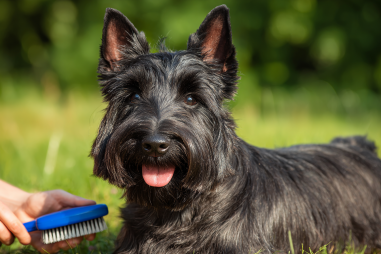Bringing home a Scottish Terrier puppy is an adventure filled with joy, laughter, and a fair share of challenges. These charming, spirited little dogs are known for their distinctive look and big personality packed into a compact frame. However, like any puppy, they require dedicated care and attention to thrive. If you’re a new owner eager to provide the best start for your Scottish Terrier, this guide covers everything you need to know—from socialization and nutrition to grooming and health concerns. Let’s dive into essential Scottish Terrier puppy care tips that will help your furry friend grow up healthy, happy, and confident.
Early Socialization and Training Basics
Socializing your Scottish Terrier puppy early on is crucial. These dogs are naturally curious and can be territorial, which means early exposure to different people, animals, and environments will help shape a well-rounded adult dog. Start gently introducing your puppy to various sights, sounds, and experiences in a positive and controlled manner. Puppy socialization classes can be an excellent way to achieve this while also getting some foundational training.
Training your Scottie puppy should begin from day one with basic commands such as sit, stay, come, and leash walking. Scottish Terriers are intelligent but can be stubborn, so patience and consistency are key. Using positive reinforcement techniques with treats, praise, and playtime motivates them to learn and builds trust between you and your puppy. Additionally, consider crate training and establishing house rules early to foster good behavior and reduce accidents.
Nutrition and Feeding for Puppies
Feeding a Scottish Terrier puppy properly is the foundation of good health. Puppies need a diet rich in nutrients, particularly protein and fat, to support their rapid growth and energy needs. Choose a high-quality commercial puppy food formulated specifically for small breeds, or consult your veterinarian for homemade diet recommendations.
Scottish Terriers have a tendency to overeat if allowed, so portion control is essential to avoid obesity. Typically, a puppy should be fed three to four times a day until about six months old, then gradually transition to two meals per day as an adult. Always provide fresh water and avoid giving excessive treats or human food, which may upset their digestive system.
Vaccinations and Vet Visits
Regular veterinary care is critical in your Scottish Terrier puppy’s early months. Core vaccinations protect against infectious diseases such as parvovirus, distemper, and rabies. Most puppies will have a vaccination schedule that starts at 6-8 weeks old and continues with boosters until they are about 16 weeks old.
At the vet, your puppy will also receive deworming treatments and be checked for any congenital issues. It’s an ideal time to discuss spaying or neutering options and microchipping for identification. Establishing a good relationship with your vet helps ensure you have reliable guidance on your Scottie’s health needs throughout their life.
Safe Environment Preparation
Preparing a safe home environment for a Scottish Terrier puppy helps prevent injuries and encourages positive behavior. Because Scottish Terriers are small but sturdy hunters by nature, they love to dig and explore. Puppy-proof your home by securing electrical cords, removing toxic plants, and keeping harmful substances like cleaning chemicals out of reach.
Create a designated play area that contains their toys, bedding, and food bowls. This space should be comfortable and free from hazards. Additionally, be mindful of small gaps or spaces they could slip into or get stuck. Supervise outdoor playtime and set up secure fencing if you have a yard, as Scotties can be curious escape artists.
Grooming for Young Scotties
Grooming your Scottish Terrier puppy from an early age helps them get accustomed to the routine and keeps their coat healthy. The breed’s thick, wiry double coat requires regular brushing, ideally several times a week, to prevent mats and tangles. Use a slicker brush combined with a comb to gently remove loose hairs and debris.
Bathing should be done only when necessary, using dog-specific shampoo to avoid drying out their skin. Their characteristic beard and eyebrows also need occasional care—wipe these areas regularly to prevent staining and odor. Nail trimming, ear cleaning, and teeth brushing are other important grooming tasks to introduce early on, making maintenance easier as your Scottie grows.
Common Puppy Health Concerns
Being aware of common health problems in Scottish Terrier puppies helps you spot potential issues early. This breed is prone to conditions like von Willebrand’s disease (a blood clotting disorder), allergies, and some inherited eye diseases. Regular vet check-ups are vital to monitor your puppy’s development and catch any signs of illness promptly.
Watch for symptoms such as lethargy, changes in appetite, coughing, persistent scratching, or unusual lumps. Promptly addressing these concerns with your vet can significantly improve outcomes. Additionally, maintaining parasite prevention with flea, tick, and heartworm treatments protects your puppy’s overall wellbeing.
Building a Strong Foundation for a Happy Life
Caring for a Scottish Terrier puppy requires time, effort, and patience, but the rewards are abundant. By focusing on early socialization, consistent training, balanced nutrition, preventative health care, and attentive grooming, you set your puppy on the path to a long and joyful life. Remember, every Scottish Terrier has a unique personality, so tune into your puppy’s needs and celebrate their quirks along the way. With love and commitment, your Scottish Terrier will grow into a loyal and delightful companion, enriching your life for years to come.







